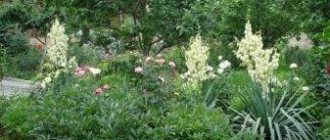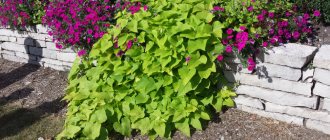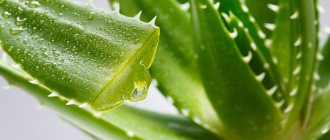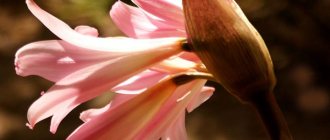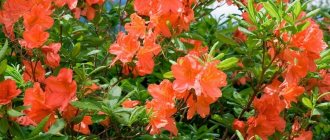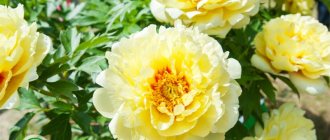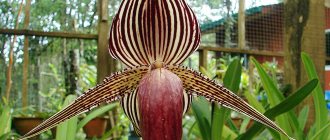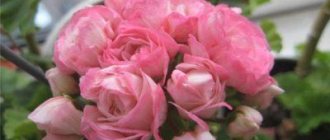The genus Episcia belongs to the Gesneriaceae family, and, according to The Plant List, has 12 species. For most of the twentieth century, almost 40 species were included in the genus Episcia, but since 1978 it has been limited - the famous German botanist and taxonomist Hans Joachim Wieler separated it into separate genera:
- Paradrymonia;
- Chrysothemis;
- Alsobia;
- Nautilocalyx.
The validity of the separation of these genera from Episcia is confirmed by recent results of phylogenetic studies. The description of Episcia was made in 1829 by the German botanist Carl Friedrich Philipp von Martius (1794 - 1868). The name of the genus goes back to the Greek word episсios - “shaded”. Because of its unusually beautiful painted leaves, Episcia is often called the “peacock flower.”
In its natural habitat, the plant grows on loose litter under the shade of tropical forest trees and along the overgrown banks of rivers in the south of America and its central part: in Colombia, Brazil, Mexico, and the Antilles. Some species are epiphytes and “live” on trees next to rhipsalis, bromeliads and orchids. Until recently, episcinias were thought to grow at low altitudes, but in 2008 a new species, Episcia duideae, was discovered in Venezuela - found in mountains at altitudes of 1500 to 1600 meters.
Description
Episcia is valued for its foliage. It comes in a variety of colors: emerald, jade, bronze, copper, silver. The greenery shimmers with mother-of-pearl. In many species, a pattern is observed along the central region of the leaf.
Leaf plates have different shapes: round, oval, elliptical. Their surface can be smooth with shine or pubescent, similar to velvet. The edges are smooth and jagged.
A bell-shaped inflorescence on a short stalk with 5 petals. Blooms in July-September. The formation of fiery red buds occurs in single quantities or in bouquets. It has creeping shoots and tendrils, like strawberries. Thanks to them, the plant reproduces.
Flower placement
Signs and superstitions about begonia in the home
Experts recommend keeping it in your office or on your desk at home. Housewives place it in the kitchen, where the flower stimulates culinary masterpieces. This undoubtedly affects the health of household members. After all, it is known that you need to cook food in a good mood.
A flower pot with episcia, located in the living room, will contribute to the well-being of the family and the ability to find joy in communication between different generations.
It is beneficial to place a pot with a flower plant in the children's room so that the little child grows up active, friendly and responsive. During sleep, the episicle will have to be removed.
There are so many flowering plants in the world that it is impossible to have them all. It’s all the more pleasant when unusual crops are selected for landscaping the apartment. Episcia planted in your home will undoubtedly attract the interest of guests and the desire to have it at home.
Domestic species
Not every plant variety was able to change its wild habitat to indoor conditions. Episcia has the following varieties that can be grown at home:
| Variety | Description |
| Copper. | Large view. With an oval plate that widens at the base. Brown-greenish foliage with a red tint turning into a copper color, velvety. A white vein is observed along the central zone of the leaf, creating contrast. The lower zone of the plate is reddish. The arrow on it is bright green. The greenery shimmers in the sunlight. The inflorescence is bright scarlet or fiery. The beginning of the petals is yellowish. Flowering is observed all summer. |
| Carnation flower. | Some experts classify this variety as a separate genus Alsobia. Like all species, it has antennae with daughter rosettes, short shoots, densely dotted with small leaves at the ends. The plate is dark green, almost black. There is a purple vein running down the middle. The flowers are white with red freckles at the base. The edge of their petals is fringed. |
| Creeping. | The name is due to its strong branching, forming a dense network of shoots. The variety has small leaves (length 9 cm, width 4-5 cm). The plate is olive-colored from the upper region, dull red below, covered with villi. The leaf shape is heart-shaped. Peduncles are purple. The petals are crimson on the inside, bloody on the outside. Flowering is observed from July to September. |
| Chocolate soldier. | Has thickened leaves. A network of veins is observed on the plates, making them voluminous and embossed. The foliage is green-purple. Flowering lasts for a long time. |
| Forest beauty. | The foliage has a silver-lavender hue with a bluish tint. Pastel pink flowers are observed in single quantities. They are small in size. |
| Northern lights. | The leaves have a unique combination of lilac-gold and dark green with a brown tint. The plates are pubescent, with cross veins. The petals are bright scarlet. |
| Silver glow. | The leaves are elongated, oval with pointed ends. Greens of a soft light green tone with a silvery mound. Rare flowers of a scarlet hue are observed between the leaves. |
| Blue Nile. | It is quite rare. Produces heavenly flowers with a lavender tint. Their middle is yellow. The foliage is brown-green with fluff. In the middle there is an olive-greenish stripe with middle veins. |
| Silver skies. | The rusty-red inflorescences contrast strongly against the background of silvery foliage. |
| Pink Panther. | Does not require special care, grows to large sizes. The flowers are large, bright strawberry. The foliage is green with a limestone, bronze tint. The plates can reach fifteen centimeters. |
| Pink akazhu. | The leaves are silver-green with snow-green stitches and splashes of pink. It blooms with reddish-red inflorescences with a yellowish core. |
| Tiger stripe. | Similar to tiger epic. A distinctive feature is the fine greenery with silvery veins. |
| Strawberry patch. | It has small leaves with pointed ends. The greens are bright, pinkish-red in tone. Scarlet buds with a lemon base. |
| Chocolate cream. | Silvery brown green with pinkish lines. The inflorescences are red. |
| Ronnie. | The buds are coral, the leaves are brown with silver-green veins. |
| Degas. | The leaves are brown-green with lines. The inflorescences are large and red. |
| Aloha Mauna Loa. | It is distinguished by quilted leaves similar to dark green velor. Reddish-red flowers. It is a hybrid bred specifically for home use. |
| Dutch. | The leaves are dark brown, velvety, medium in size. The light green, silvery pearlescent veins have a herringbone pattern. The inflorescence is red with a pinkish tint. |
Watercolor varieties are also bred at home. They are distinguished by an unusual foliage color and are not found in natural conditions. The following species are in demand among gardeners: Danae, Inessa, Black Queen, Strawberry mist (Strawberry mist) and Strawberry patch, Safari, TM-Sahara, Tiger stripe, Tricolor, Brown beauty, Panama white, Lilacina viridis, Sun Gold (Chimera), Dixie Dynamite, Smoky Topaz, Country Kitten, Coco, Gray Lady, Longwood, Sea Foam, Neptune, Silver Tire, Miniature Symphony (symphony), Seduction, Sports, Suomi, Helen Dixie.
Varieties and names with photos
| Type of epic | Leaves | Flowers |
| Dianthiflora episcia dianthiflora | Oval, pubescent, in shades of green | White, tubular, carnation-like |
| Type of epic | Leaves | Flowers |
| Creeping episcia reptans | Hairy, silver-green | Carmine, edged with fringe |
| Copper-red episcia cupreata | Elliptical, large, brown to copper | Yellow corolla, red spots |
| Type of epic | Leaves | Flowers |
| Chocolate soldier episcia chocolate soldier | Brown-green, silver-blue dots | Dark burgundy |
| Type of epic | Leaves | Flowers |
| Forest beauty episcia silvans beauty | Glossy, in shades of silver | Carmine, red |
| Type of epic | Leaves | Flowers |
| Northern lights episcia northern light | Glossy, pearlescent shimmer | Reds |
| Silver shine episcia silver sheen | Hairy, shades of silver, edged with green or brown stripes | Orange-red |
| Type of epic | Leaves | Flowers |
| Lilacina viridis | Large, pubescent, finely toothed, emerald green, with a scattering of silver veins | Lavender, lilac, with white rim |
| Kee wee | Large, rough, shiny, with a brown coating | Orange-red, yellow throat |
| My precious | Large, glossy, lumpy, green-light green, with pearlescent veins | Yellow, lightened edge |
| Type of epic | Leaves | Flowers |
| Yellow mist | Large, smooth, with silvery pearl scattering along the veins | Bright yellow |
| Type of epic | Leaves | Flowers |
| Gray lady | Hairy, medium, jagged, in olive shades | Red, orange, yellow polka dots |
| Silver dust | Medium, dark, olive green, with contrasting mesh veining | Carmine, orange, edged with a light rim |
| Type of epic | Leaves | Flowers |
| Faded jade | Light green, with pearlescent coating along the central | Orange-red, yellow throat |
| Сhocolate cream | Chocolate brown with wide pink veins | White, fringed edges |
| Type of epic | Leaves | Flowers |
| Silver skies | Miniature appearance, in shades of green, with a crimson tint | Carmine |
| Tiger stripe | Swamp shades, with veins similar to the pattern of tiger skin | Scarlet |
| Type of epic | Leaves | Flowers |
| Pink acajou | Medium, finely toothed, silver-green, with random pink splashes | Carmine |
| Type of epic | Leaves | Flowers |
| Moon light | Light silver, with brown-pink edge | Reds |
| Sun gold | Small, olive, with brown tones, shiny, herringbone | Bright yellow |
| Type of epic | Leaves | Flowers |
| Butternut | Light green, with brown spots, young leaves - pink shades | Reds |
| Type of epic | Leaves | Flowers |
| Spring symphony | Glossy, large, dark olive | Orange, jagged edges |
| Aloha mauna loa | Round, hairy, dark brown tortoiseshell color | Orange-red |
| Type of epic | Leaves | Flowers |
| Pink Panther | Hairy, dark green, herringbone pattern | Hot pink, jagged |
| Type of epic | Leaves | Flowers |
| Country kitten | Small, embossed, chocolate-colored, with silver-pink veins | Red-orange |
| Sea foam | Round, pubescent, raspberry-pink in color, with a pink border and an olive stripe | Orange-red, yellow throat |
| Type of epic | Leaves | Flowers |
| Veronica's hair | Cherry, with mother-of-pearl insert | Scarlet |
Home care
Epistomy care at home should be carried out according to all the rules:
| Factor | Recommendations |
| Location | Location matters when growing. It is recommended to place the pot on a windowsill on the north side. If this is done from the south, the plant moves a couple of meters from the window. When placing a flowerpot from the west or east, it is hung on the left or right side of the window sill. |
| Lighting | The light should be diffused. The plant does not like direct sunlight. In winter, additional lighting is needed to extend daylight hours by several hours. |
| Humidity | The minimum humidity level is 60%. To increase it, it is recommended to place containers with aqueous solutions or moss, expanded clay, coconut fiber, peat near the episcia, moistening them. If this is not enough, then the pot with the plant can be moved to the kitchen (there the air humidity is higher). Perform spraying and wiping. |
| Temperature | Episcia does not have a rest period. Feels comfortable at +22° to +26°C. In winter, the temperature can be lowered to +18°C. At +16° the flower dies. At +30° or more it will survive, but with proper watering. |
Pot, soil, replanting
The rhizomes of the flower are thin and fragile. They creep close to the ground surface. Therefore, for planting you need to choose a shallow pot or a wide bowl. The plant is planted in groups (three or more).
When growing a flower using the “carpet” method, you need to select a large pot so that there is enough space for the tendrils to grow. If planting is done in a hanging pot, then the container can be taken smaller: the mustache will hang down.
The soil is light, with medium acidity. The soil consists of leaf soil, peat and sand (3:1:1). Sphagnum and ash are added. Drainage is required: the bottom is lined with expanded clay or polystyrene foam (layer three centimeters).
The plant grows quickly; it is replanted once every twelve months. This happens as follows:
- episcia is watered and carefully removed from the pot;
- the root is inspected: dried and rotten areas are removed;
- a drainage layer of 3 cm is laid on the bottom, soil is poured on top;
- planting and watering are carried out.
The circumference of the pot for replanting should not exceed 20 cm.
Interesting things about the epic
- Episcia leaves have a rare property for plants - under natural or artificial light, they reflect the light falling on them towards the source of this light. The “glow” effect occurs if the plant is placed on a stand or hung in a flowerpot on the side of a window and no longer rotated or changed its location. Under this condition, the leaves will form a continuous, flat surface capable of glowing intensely. If the plant is turned to the light source in different directions, the leaves will not reflect the light synchronously.
- Episcia does not tolerate tobacco smoke at all.
- Episcia always reacts sensitively to the owner’s attitude towards her. Reciprocates love and proper care with lush flowering and good growth.
- In a house where episcia grows, family relationships become harmonious.
Watering
Abundant watering is necessary from early spring to October, every other day. When watering, it is necessary to take into account the temperature and humidity of the air. In winter, you can carry out the manipulation less often: wait until the soil on top is completely dry. Any water that has drained into the pan must be poured out immediately. Excess moisture will destroy the plant, as will drying out.
The water is taken soft, settled for 2-3 days. Temperature - +28-+30ºС. Tap water is softened with lemon acid.
You need to make sure that the drops do not get on the greens: use a watering can with an elongated spout. Water is poured along the edges of the pots.
Main varieties
Copper, copper-red or fire episcia (Episcia cupreata) is most in demand among connoisseurs of indoor flowers. Its velvety leaves are decorated with a fine mesh of silver veins, and against the background of a copper tint and burgundy edging they look bold, although other leaf color options are also acceptable. Their shape resembles hearts or ovals, and their length varies around 10 cm. From mid-summer to late autumn, the bushes are decorated with scarlet flowers with yellow tubes. Despite the miniature size of the flowers, the plant looks very bright due to their large number.
Breeders obtained “Silver Light” based on the copper variety described above. The leaves have a light green pattern, burgundy speckles and a beautiful copper edge. There is also a silver tint visible in the middle of the leaf. The flowers are colored red-orange.
The lilac episcia is distinguished by even more burgundy leaves, and at the bottom they have an almost red color. Flowers of pastel shades are larger than those of the copper “relative”.
'Blue Nile' is descended from a purple variety, but its flowers are a deeper blue with a yellow center. This rare coloring for episcia is valued by flower growers. The leaves of this variety have a rather modest color.
"Silver Skies" The main distinguishing feature of the variety is its charming small silver leaves without any admixture of other colors.
The carnation-flowering variety belongs to the ampelous variety. Its sprouts either stretch long and produce rosettes, or are short shoots with tendrils. Small green leaves with a purple stripe in the middle strew the stems and young shoots. From June to September, this flower delights owners with white flowers with lilac dots.
Creeping epic. Not suitable for growing in pots. The long stems have 10-centimeter spotted leaves, the color of which depends on the location of growth. In the shade they turn green with a metallic tint, and in the sun they turn brown. From mid-summer to early autumn it is covered with red flowers.
"Pink Panther". The leaves of this variety amaze with their unusual coloring – white-green with a bronze tint. Their length is quite large - 15 cm, and the pink flowers are large in size. Growing a pink panther is not difficult, as it does not require painstaking care.
"Pink Brocade". The variety is also distinguished by the unusual color of its leaves - they have a pale pink edge and the same inclusions, and in the center the color varies from green to silver.
“Moon Valley” even has a red edging on the leaves, and their core is light green with a tint.
“Chocolate velor” amazes flower growers with a combination of brown and purple in the color of the foliage, and in some lighting they even give a pink tint. The highlight of the plant is its delicate blue flowers.
'Chocolate Soldier' has brown leaves with silver-blue spots and cherry-colored flowers.
"My Precious" blooms yellow, and its leaves are colored light green.
"Gray Lady" with ordinary green leaves stands out with scarlet flowers with yellow polka dots.
Top dressing
During active growth, fertilizing with organic or complex fertilizers for indoor flowers is recommended. They also use fertilizer for decorative foliage and flowering plants. You can buy it in a specialized store.
The dosage is indicated on the fertilizer packaging; it is reduced by 2-2.5 times.
Feeding is done twice a month. There is no need to fertilize the soil in autumn and winter. When the soil is dry, the event cannot be carried out: the roots can be burned.
Care errors and their elimination
The table contains frequently encountered problems when growing Episcia and methods for eliminating them:
| Problem | Causes | Solution |
| Brown spots on leaves | Watering with cold water | Water the soil with warm, settled water |
| Yellowing of leaves | Excess fertilizer, low air humidity, hot air | Fertilize only during the period of active growth, no more than 2 times a month, ensure a temperature of +20-24°C, increase air humidity |
| Gray coating on leaves | Soil acidification, insufficient ventilation | Transplant the plant into a fresh substrate, regularly ventilate the room, but avoid drafts |
| Faded color of leaves, stretching of stems | Inappropriate lighting | Provide the plant with diffused light |
Reproduction
Methods:
- seed;
- daughter sockets;
- side shoots;
- cuttings.
When propagated by seeds, the plant loses its varietal characteristics in 90% of cases. Planting is done in January or June in the surface layer of the earth, without sprinkling. Seeds require greenhouse conditions of +20ºС. The first shoots appear after 10-14 days. After a month they can be transplanted into separate containers.
When propagated by rosettes, without separating them from the adult episcia, they are buried in the soil and rooted. After this, the flower is placed in a new flowerpot or planted next to the mother plant. The roots appear after a week.
Carefully cut cuttings, pre-treated with Kornevin, are planted in previously prepared soil. Covered with glass. Within a few days the cuttings will take root.
Developed tendrils are cut from the mother plant. Each is divided into three parts and rooted in water. Next comes disembarkation.
Epiphany in the house: signs and superstitions
There is a sign that if you give an epic, it will bring love to the giver. But the one to whom it was given will receive a lot of benefits from the flower.
Episcia can raise vitality, bring joy, and improve communication in the family. It cannot affect mental activity, but it gives a good mood, creativity, and allows you to enjoy work.
We can say with confidence that the main purpose of culture is to bring joy. Therefore, placing the epic is appropriate in almost any room - in the kitchen, in the bedroom, in the children's room.
Episcia is an exotic plant that can be grown as a bush on a windowsill or in hanging pots, letting the shoots hang down. The culture is popular among gardeners not only for its decorative leaves and flowers, but also for its unpretentiousness, unlike many other representatives of the tropics.
Below is a video about the methods of propagating Episcia and the nuances of keeping the plant at home:
Sources
https://ru.wikipedia.org/wiki/%D0%AD%D0%BF%D0%B8%D1%81%D1%86%D0%B8%D1%8F
https://stroy-podskazka.ru/episciya/raznovidnosti/
https://fikusexpert.com/komnatnye/ampelnye/epistsiya.html
https://pocvetam.ru/komnatnye-rasteniya/episcia-uhod-v-domasnih-usloviah.html
https://MrDachnik.com/episciya
https://stroy-podskazka.ru/episciya/vidy-sorta/
https://room-plant.ru/komnatnye-rasteniya/ampelnye-rasteniya/epistsiya/uhod-v-domashnih-usloviyah-9/
https://ProZvety.ru/katalog-rastenij/ampelnye/ehpisciya-vidy-sorta-nazvaniya-foto
https://podomu.info/comfort/plants/bloomy/various/episcia.html
[collapse]
Possible problems
When care errors occur, problems arise:
| Problem | What is the reason and how to eliminate it? |
| Brown spots of irregular shape form on greenery. | When watering, too cold water is used. It must be warmed up before the procedure. |
| The greenery turns yellow and falls off. | There is an excessive amount of nutrients in the soil: you need to fertilize the plant less often. The reason may lie in prolonged exposure to ultraviolet rays or too much watering. |
| The foliage is curled into a tube. | The flower is watered rarely, but abundantly. |
| The ends of the leaves become brown and dry out. | Lack of moisture in the air or ground. |
| The leaves fade, become dull, and become smaller. | The plant lacks light. It must be placed closer to the window or additional lamps must be used. |
| The greens are covered with a pale dirty or gray coating. | The flower does not have enough fresh air: the room needs to be ventilated regularly, or a transplant is necessary. |
| Doesn't bloom. | Episcia is watered very rarely, the soil has time to dry out. It may also be due to an excess of nitrogen in the soil, lack of fertilizer, dry or cold air. |
| Poor flowering, stretching of stems. | The plant does not have enough light. |
How to care for episcia
Important conditions for the comfortable content of the episis are:
- Maintaining a constant temperature without sudden changes. Sudden temperature fluctuations, especially strong drafts, will stress the plant.
- Smoking is not allowed in the epicenter room.
- Attention to the leaves: dust settling on the leaves should be regularly removed with a soft brush and not with a wet cloth. To ensure that the plant breathes and does not experience oxygen starvation, keep its leaves clean.
READ MORE: Kitchen design with a window - how to place a countertop, sink, work area or sitting area by the window (100 best photo ideas)
Diseases, pests
Methods for eliminating diseases and pests:
| Disease | How to recognize? | Prevention and treatment |
| Chervetsy | The plant turns yellow and dries out, a gray coating and lumps similar to cotton wool appear on the leaves. | It is recommended to maintain high humidity in the room: this prevents the pest from multiplying. It is necessary to remove dried leaves. The plant can be treated with cotton wool soaked in soap suds or sprayed with the same liquid. In the store you can buy drugs against parasites: Tanrek, Apache. |
| Nematodes | These are worms that infect the rhizome. The plant grows poorly and its leaves curl. | It is necessary to maintain the required temperature conditions and follow the rules of watering: heat and excess moisture help nematodes to reproduce. To get rid of the parasite, the roots of the plant are immersed in hot water +50ºС. Solutions of Mercaptophos and BI-58 help. When a plant is severely affected, it has to be destroyed and the soil thrown away. |
| Root rot | The roots become soft and the foliage withers. | To prevent the formation of rot, you need to drain excess water in a timely manner and avoid stagnation. When planting and transplanting, it is recommended to use the drug Glyokladin. To get rid of rot, you need to disinfect the pot and available tools. |
| Spider mite | The foliage becomes translucent, fades and dries. The petiole has a cobweb. Beige-yellowish plaques appear at the bottom of the leaf blades. | It is necessary to increase air humidity, perform quartzing twice or thrice a week (especially the lower part of the leaf). To get rid of the parasite, the pot is disinfected; you can buy poison in the store. You can cope with the problem if you keep the plant in a container with onions, horseradish, tobacco or kerosene infusion, wrapped in plastic, for three to four days. The flower is sprinkled with dried black henbane powder. |
| Thrips | Parasites can be seen with the naked eye by shaking the leaves. They are small, dark brown or black. Grayish-brown lines appear on the foliage, looking like scratches. The greens become whitish or silvery. | To avoid illness, the room is ventilated and humidity is maintained. It is recommended to install devices for catching flies next to the pot. Other plants should be placed away from the episcia. To exterminate the pest, purchased poison is used. Onion and garlic infusions are placed nearby. The flower is watered with decoctions of medicinal herbs. |
What care does any variety of this flower require?
Since Episcia is a former resident of the tropics, it likes dark and damp places, as well as a complete absence of drafts.
Choice of window sill. Western or Eastern - that's it! If you only have one window, and it faces south, this is also not a problem. Keep the plant on the windowsill from evening to morning, and hide it in a dark corner during the day (or at least from 10 a.m. to 2 p.m.). Or even buy a hanging pot and hang the plant a little away from the window. As for the north window, it is not suitable at all - there is little light here.
- Temperature. Ideal: 22-25 degrees. The “critical points” for a flower are considered to be 16 degrees (if it gets even colder, it will die) and 36 degrees (it doesn’t like extra heat either). Although it is better for a flower to live in heat than in cold, the main thing is that you do not forget to water it constantly.
- Priming. Choose a light one that will not interfere with the roots’ breathing. If you don’t like the store-bought soil, mix river sand, leaf and garden soil in equal doses, dilute it all a little with charcoal (charcoal) and sphagnum. But this is not enough: add drainage to the pot (to the bottom, about 3 cm) - small pebbles or expanded clay.
- Feeding. You can remember about it in spring and summer, adding nutrients at least every week. Any mineral fertilizer for flowers will suit you, but take half the usual (indicated on the package) norm.
- Pests. They rarely visit such a plant. Episcia can only become infected with nematodes or apple aphids.
- Diseases. The main problem of the flower is excess water in the pot, which can cause the roots to rot. The leaves have dark spots: stop watering the flowerpot with cold water. Yellow spots: these are sunburn, overfeeding or too dry air.
Watering and water procedures
This is one of the most water-loving flowerpots - you can water it every 3 days. Do not add too much - stagnation of water will provoke the appearance of root rot, which will destroy the plant. But as soon as the soil dries completely, immediately add water. Moreover, pour directly onto the ground - leaves (especially those with edges) do not like to be washed.
In the cold season, “hibernation” affects even this restless creature, so watering can be reduced to once every 7 days. Is the soil dry? Don't rush, wait a day or even two with water.
Leave the water to settle, allowing it to warm up to a comfortable room temperature - under no circumstances should it be icy.
Episcia does not respect spraying, but loves moist air. What should I do? It's simple: fill a tray with expanded clay, fill it with water, place a pot with a flower on top, but so that the roots do not reach the plant - and let it breathe moisture.
Transplantation, bush formation
Most plants change their place of residence once a year, but episcia can be replanted twice.
Choose a wide “house” (5 cm wider than the old one) with narrow sides that will not prevent the plant from hanging over the sides of the pot. And of course, there must be holes in the bottom!
The whole procedure goes like this:
- Water your pet well to soften the soil.
- After half an hour, remove the plant, very carefully moving the roots - do not pull the branches, it is better to knock on the walls so that the roots come out easily.
- Carry out a “medical examination” of the roots: if you see rotten or dried roots, cut them off with a margin and cover the “wound” with sulfur.
- Place drainage and fresh soil in the new pot.
- Plant the episcia and water it. After 30 minutes, check to see if excess liquid needs to be drained from the pan.
- Do not expose the pot to the sun for at least 7 days.
Pruning the crown is a common thing for episcia, because it always wants to take over the world... Well, or at least your entire room. It is better to cut off excess leaves with sterile scissors (boil them for about 10 minutes).
How to propagate Episcia
- Sockets. The easiest way. In spring, the plant produces tendrils, at the ends of which “mini bushes” grow. Mix peat with sand, plant this bush there (without cutting off the mustache), keep it warm. When it releases the roots and firmly “grabs” the soil with them, you can cut off the “umbilical cord”.
- With a cutting. Cut the cutting, stick it into a glass/pot with soil, and cover with a jar on top to create a greenhouse effect. When the roots begin to grow, you can pick up the jar.
- Seeds. They are sown in a well-drained box, which is wrapped with film on top. By the way: this method is bad for hybrid varieties - after germination they may look not like themselves, but like the “mother”, that is, the parent variety.
If after reading this article you still have questions, I recommend watching this video. In it, a florist who has been successfully breeding epicias for a long time shares her experience.
She has a lot of pets - some are in pots, others are in the form of children, and all are well-groomed and healthy. The video is not short, but extremely useful:
EPICTION - PLANTING AND CARE. GROWING TIPS FROM GARDENERS
AMPLE EPISTIA AND HOYA
In my flower collection there are two wonderful hanging plants - Hoya bella and Episcia. They appeared at different times, but they grow side by side, complement each other with their beauty and are not capricious in their maintenance.
Episcia and hoya - photo
EPICTION
The cutting quickly took root (it was summer) in a plastic cup with universal soil. When it was time to choose a permanent place for the plant, I placed it in company with other hanging plants near the south window, where there is enough light. Replanted it in a small pot, in a mixture of universal soil, garden soil and vermiculite (2:1:1), pouring drainage - pieces of polystyrene foam. The beauty gradually grew rosettes with silver leaves, and in the spring she pleased with scarlet flowers. I water it when the soil dries out. I feed with complex fertilizers for decorative deciduous species according to the instructions. If the appearance of a plant deteriorates over time, I rejuvenate it by planting young rosettes.
HOYA
A little later, I placed a hoya on the wall next to the plant - a rooted cutting, planted in a small pot in loose cactus soil mixed with universal soil, with expanded clay at the bottom. I water the plant only after the substrate has completely dried. To avoid rotting, I reduce watering in winter. The delicate flowers that appear in the spring transform the hoya. I haven’t cut it yet, remembering that the inflorescences form at the ends of the shoots, and only replanted it once. I feed with complex fertilizers for beautiful flowering species. Sometimes, to prevent diseases, I add Fitosporin to the water (according to the instructions). I haven’t noticed any pests yet, but when treating other plants against spider mites, I also spray hoya with episcia for preventive purposes.
